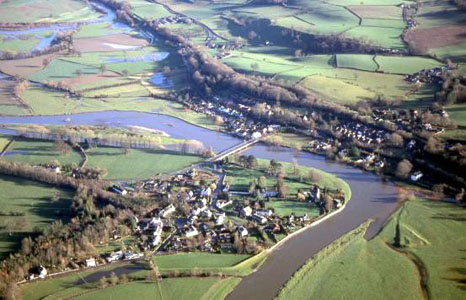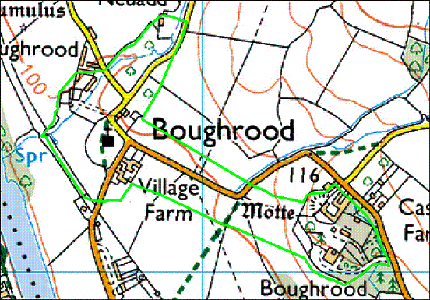|
Boughrood Settlement to 1750 Clwyd Powys Archaeological Trust Historic Settlements Survey - Radnorshire |
Boughrood SO 12783920 Introduction Boughrood has developed on the terrace on the east side of a
small unnamed stream where it runs into the River Wye. The ground
rises gently to the east and, separated by the shallow valley
of another brook, Boughrood Castle surmounts a spur projecting
towards the Wye. The settlement lies about 14km to the north-east
of Brecon and just over 10km south-west of Hayon- Wye. |
|
|
|
|
History of development The heritage to 1750 The small church of St Cynog (16005) was rebuilt in 1854. Nothing of its predecessor remains, but earlier 19th-century reports, particularly that by Sir Stephen Glynne suggest a simple building with nothing remarkable about it. The churchyard (16082), irregularly circular, is raised up to one metre internally in its southeast quadrant. The northern two-thirds of the interior is raised above the rest but this could be due to the natural ground slope or past burial practice rather than being the relic of an earlier smaller 'llan'. The Tithe survey shows that in the mid-19th century a lane or track encompassed the entire churchyard, but by the end of the century those parts of the track on the west and south had been incorporated into he churchyard. Earthworks of undefined character (16083) but possibly indicative of a shrunken settlement survive in pasture immediately to the north of the churchyard (7639). These though have not been subjected to field assessment. The presence of a straight lane linking the church and the medieval castle could also signal the possibility of a settlement emerging to the east of the churchyard, though there is as yet no substantive evidence to support this contention. Surrounding the churchyard are three cruck-framed houses, Boughrood Court, a cruck-framed hall-house (16084), Forge Cottage (16085) and the initially timber-framed Village Farm (20620), all with 17th-century and in two cases perhaps even 16th-century origins. Neuadd, a short distance to the north, also appears to be 17th-century. Nearly 500m to the east is Boughrood Castle (500; SAM Rd072), a low motte, its summit enclosed by a bank and containing fragments of a masonry tower, which is presumably the one referred to in the document of 1205. It has been suggested that the motte was thrown up at the end of the 11th century, and despite various vicissitudes the castle may have continued in use into the 13th century. The mound is surrounded by a ditch and outer bank but its southeast sector as well as the bailey has been destroyed during the building of the adjacent Castle Farm. Excavations on the motte top were undertaken in 1966 and revealed traces of the tower, but a full report does not appear to have been published. Boughrood Castle itself (16082) is an early 19th-century stone building with a Grade II listing, enclosed by landscaped gardens. |

